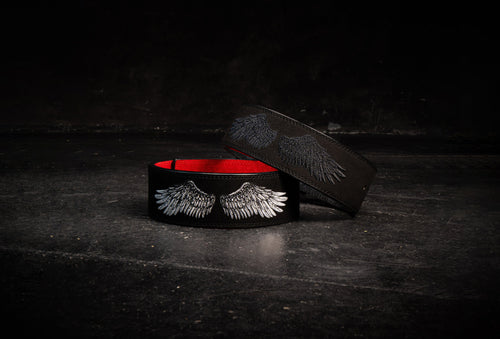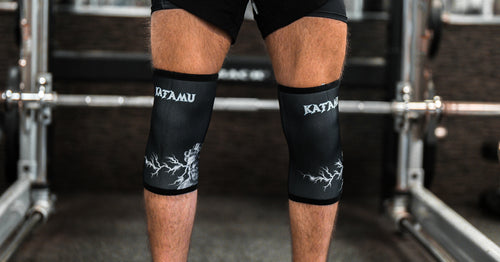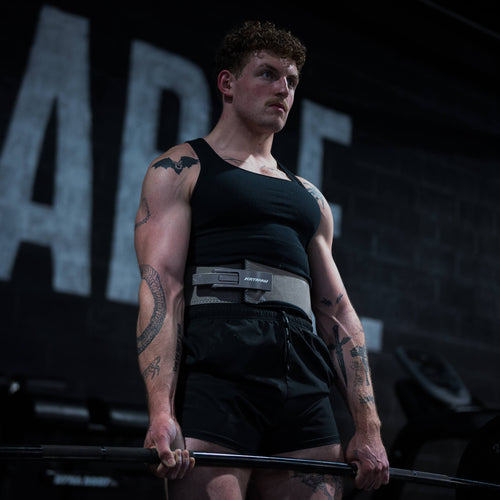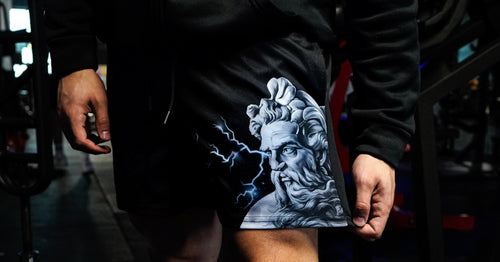Ready to unlock your true lifting potential in 2025? Understanding lifting belt weight is the secret weapon for safer, stronger lifts. In this definitive guide, you will discover how the right lifting belt weight, type, and support level can transform your performance, protect your back, and help you reach your goals. We break down the essentials, from belt basics and sport-specific picks to sizing, fit, and expert strategies. Get ready for real data, actionable tips, and everything you need to choose the perfect belt for your body and training style.
Understanding Lifting Belts: Basics and Purpose
Unlocking the secrets of lifting belt weight begins with understanding what these essential tools really are. Whether you're a beginner or a seasoned athlete, knowing the basics sets the stage for making smart, safe choices in the gym.
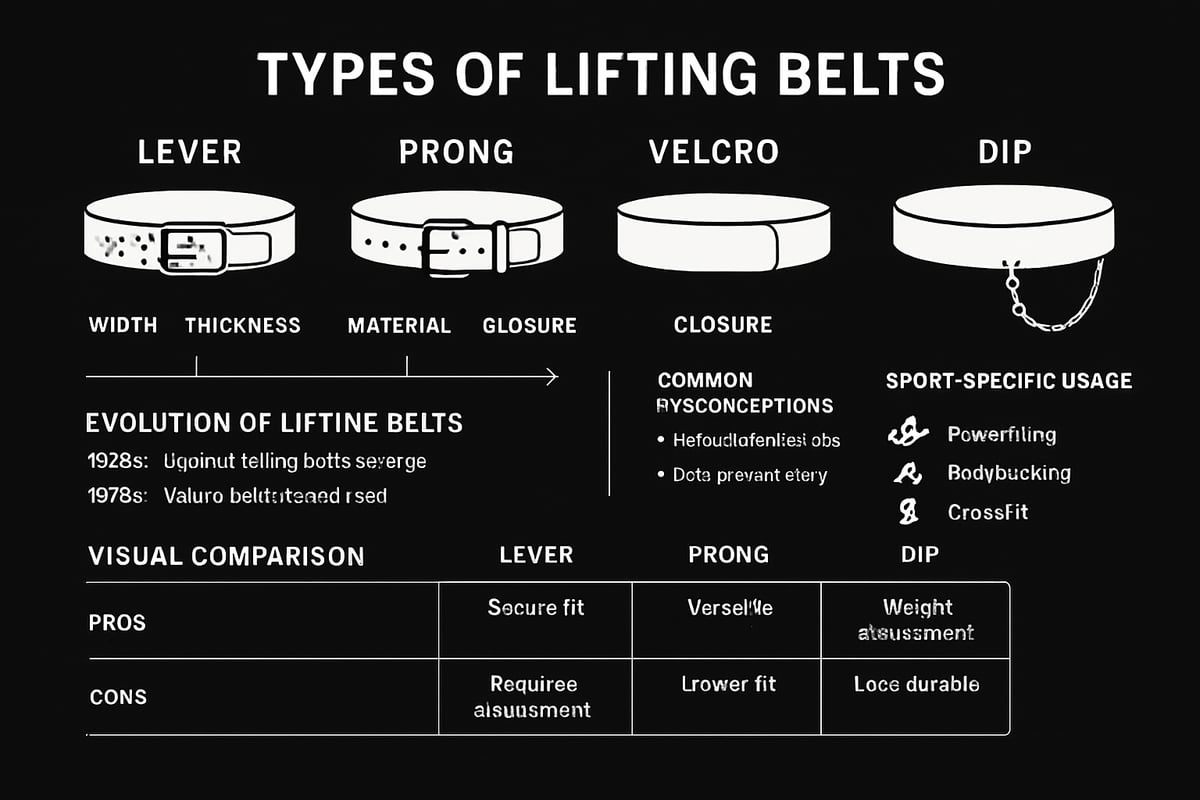
What is a Lifting Belt?
A lifting belt is a supportive piece of equipment worn around the waist during strength training. Originally used by powerlifters in the mid-20th century, these belts have evolved to serve athletes in bodybuilding, CrossFit, and Olympic lifting.
Many believe a belt is "cheating," but that's a myth. Instead, the right lifting belt weight provides extra support without taking away from your hard work.
Key components include:
- Width: Commonly 4 inches, varies by sport.
- Thickness: Ranges from 6mm to 13mm.
- Material: Leather for durability or nylon for flexibility.
- Closure: Lever, prong, or Velcro for different needs.
For example, leather belts are popular for maximum support in powerlifting, while nylon belts are favored for dynamic movements in CrossFit and Olympic lifting.
Why Use a Lifting Belt?
The main goal of using a lifting belt is to increase core stability by boosting intra-abdominal pressure. This pressure acts like a natural brace, helping protect your lower back and spine during heavy lifts.
Wearing the right lifting belt weight can reduce the risk of injury, especially during squats, deadlifts, and overhead presses. Studies show powerlifters can lift up to 10 percent more with a belt.
However, belts aren't for every set. Skip them during warm-ups or accessory work. Focus on compound lifts and heavy attempts, where support makes a real difference.
Picture a lifter grinding through a heavy deadlift. The belt keeps their form tight and their back safe, letting them push their limits with confidence.
Types of Lifting Belts Explained
There are several types of lifting belts, each designed for a specific training style and level of support:
| Belt Type | Pros | Cons | Typical Use Case |
|---|---|---|---|
| Lever Belt | Quick to secure, very rigid | Less adjustable | Powerlifting, max effort lifts |
| Prong Belt (Single/Double) | Versatile, secure fit | Takes longer to adjust | General strength, bodybuilding |
| Quick-Locking/Velcro | Fast on/off, flexible | Less support for max lifts | CrossFit, Olympic lifting |
| Dip Belt | For weighted dips/pull-ups | Not for core stabilization | Accessory lifts (dips, pull-ups) |
Lever belts, popular among powerlifters, provide maximum rigidity and speed during competition. Prong belts offer versatility for gymgoers who want a balance of comfort and support.
Quick-locking Velcro belts are the top choice for athletes needing mobility and quick adjustments, especially in CrossFit and Olympic lifting. Dip belts are a separate category, designed to add weight to exercises like pull-ups and dips but not meant for spine support.
Brands like Rogue and Gymreapers offer a variety of options to match your lifting belt weight needs. For a deep dive into belt types, materials, and biomechanics, check out this comprehensive analysis of lifting belts.
No matter your sport or experience level, choosing the right style ensures you get the support you need for safer, stronger lifts.
Lifting Belt Weight & Thickness: What Really Matters?
Selecting the right lifting belt weight and thickness is crucial for both safety and performance. With so many options, it's easy to get overwhelmed. Understanding the differences in thickness, width, and material will help you make an informed decision that supports your goals in 2025.
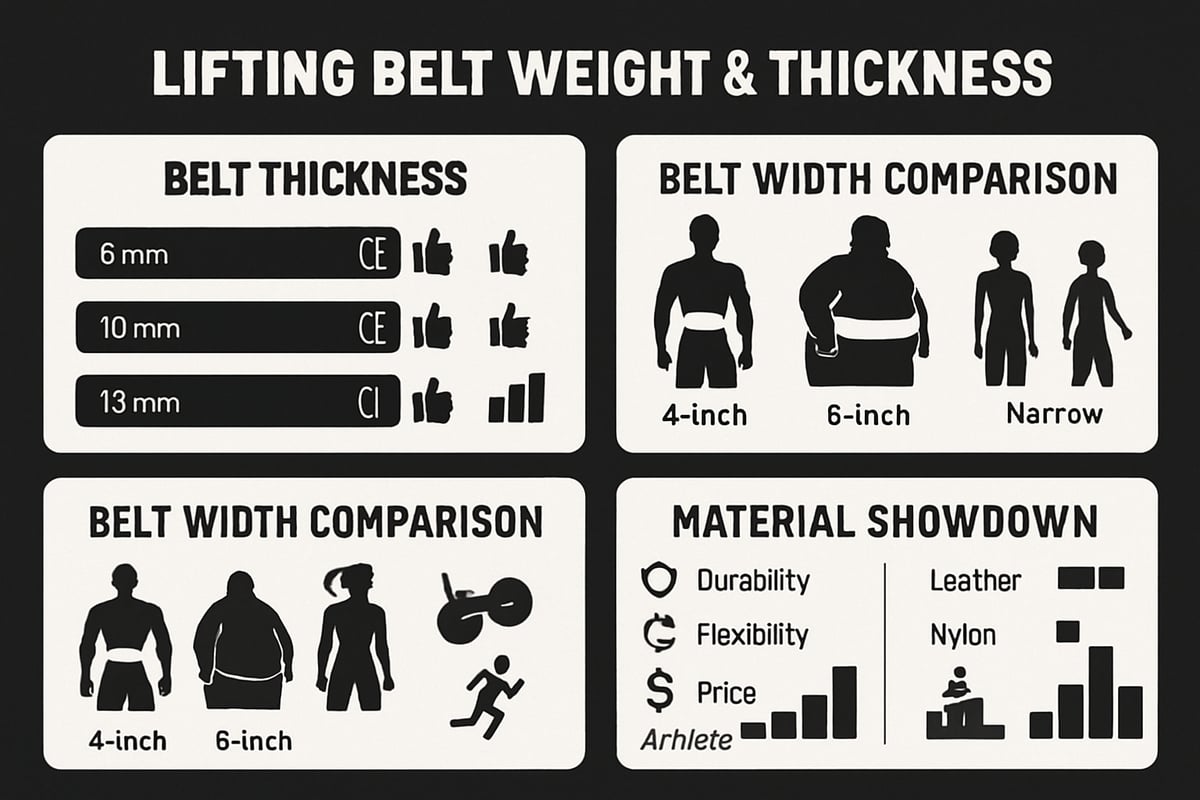
Belt Thickness: 10mm vs 13mm vs Others
Belt thickness is one of the most important aspects of lifting belt weight. Standard options include 6mm, 10mm, and 13mm belts. Each thickness provides a different balance between support and comfort.
A 10mm belt is the most popular choice among gymgoers. It offers robust support without sacrificing comfort, making it ideal for squats, deadlifts, and general strength work. In fact, 10mm belts outsell 13mm models by a 2 to 1 margin according to Gymreapers' 2023 data.
For advanced athletes or competitive powerlifters, a 13mm lifting belt weight delivers maximum rigidity and spinal support. However, it can feel bulky and requires a longer break-in period. Thinner belts, like 6mm or 8mm, are favored for Olympic lifts or by beginners who need more mobility and less restriction.
| Thickness | Support Level | Comfort | Best For | Popularity |
|---|---|---|---|---|
| 6mm–8mm | Moderate | High | Olympic lifts, beginners | Low |
| 10mm | High | Medium | Powerlifting, general | Very High |
| 13mm | Maximum | Low | Heavy powerlifting | Medium |
Comfort versus rigidity is a key factor in choosing your ideal lifting belt weight. IPF-approved belts must meet specific thickness standards, so check requirements if you plan to compete.
Belt Width: 4-inch vs 6-inch and More
Belt width plays a big role in how lifting belt weight distributes pressure around your core. The standard 4-inch belt is the most common, offering even support for most lifters regardless of body type.
Wider belts, like 6-inch models, provide additional support for larger torsos but can limit mobility during dynamic lifts. Narrower belts are better suited for smaller athletes or those focused on Olympic lifting, where freedom of movement is essential.
Gender and size also affect belt width selection. Many women and smaller lifters prefer a narrower lifting belt weight for comfort and better fit. Both Rogue and Gymreapers offer multiple widths, so you can customize your choice.
| Width | Best For | Pressure Distribution | Mobility | User Profile |
|---|---|---|---|---|
| 4-inch | Most lifts, general use | Even | Good | Most gymgoers |
| 6-inch | Large torsos, max support | High | Limited | Advanced, large build |
| Narrower | Olympic lifts, small waists | Focused | Excellent | Women, smaller men |
Choosing the right width is about balancing support and movement. Consider your sport, body type, and the type of lifts you perform most often.
Material Matters: Leather vs Nylon
The material of your belt affects both its lifting belt weight and overall performance. Leather belts are known for their durability and maximal support. They can last 5–10 years with proper care but often require a lengthy break-in period. Leather belts typically cost between $100 and $150.
Nylon belts, on the other hand, are more flexible, lightweight, and easier to adjust. They are popular among CrossFitters and Olympic lifters who prioritize speed and comfort. Nylon belts cost less, usually between $30 and $70, and are ready to use right out of the box.
Key differences include:
| Material | Durability | Support | Flexibility | Price | Maintenance |
|---|---|---|---|---|---|
| Leather | 5–10 years | High | Low | $100–$150 | Moderate |
| Nylon | 2–4 years | Medium | High | $30–$70 | Easy |
Athlete testimonials show that bodybuilders and powerlifters tend to prefer leather for its rigid support, while CrossFitters and Olympic lifters like nylon for mobility. For more on how material, thickness, and width influence your choice, check out this expert guide on how to choose a weightlifting belt.
Choosing the right lifting belt weight isn't just about numbers. Think about your training style, comfort, and long-term goals to find the perfect match.
How to Choose the Right Lifting Belt Weight for Your Goals
Choosing the right lifting belt weight is a game changer for your training. With the right approach, you unlock support, comfort, and performance gains tailored to your needs. Let’s break down the steps so you pick a belt that truly fits your goals, body, and experience level.
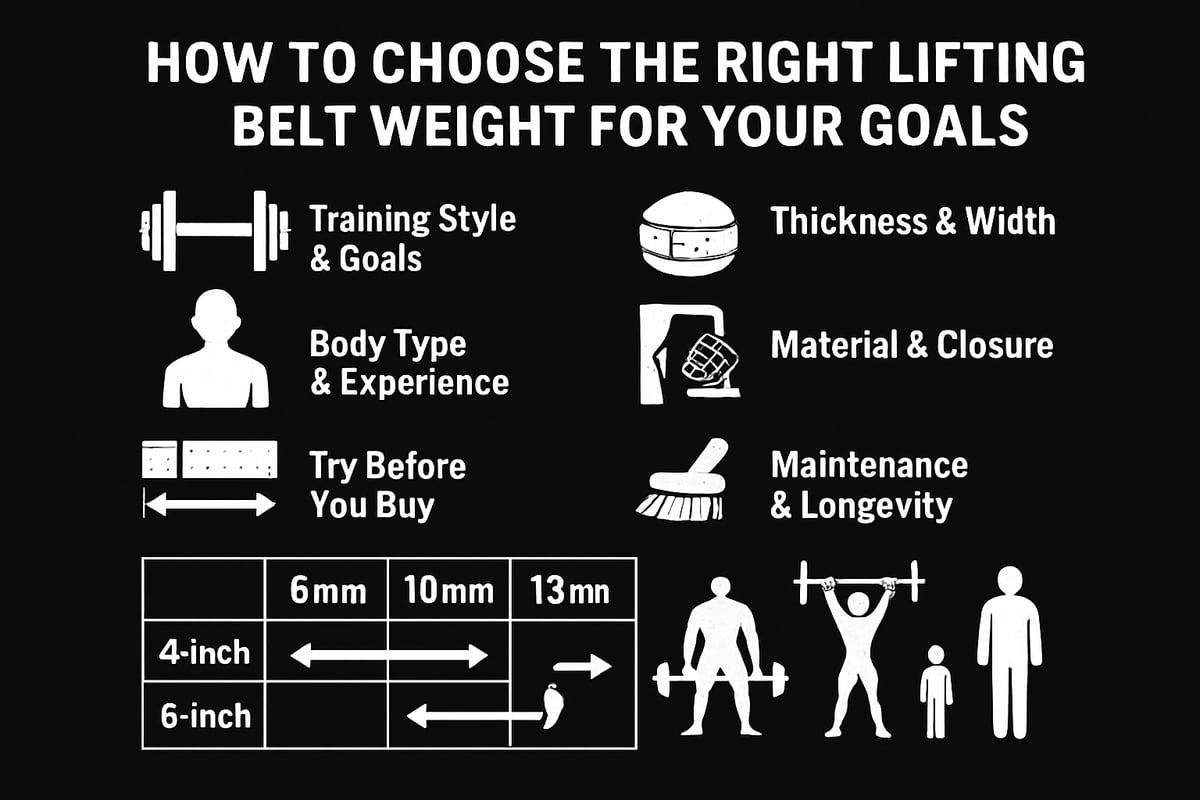
Step 1: Define Your Training Style & Goals
Your training approach is the foundation for choosing the ideal lifting belt weight. Are you focused on powerlifting, bodybuilding, Olympic lifting, CrossFit, or just general fitness? Each style puts different demands on your core and back.
If you frequently lift heavy for low reps, prioritize maximal support. Powerlifters often need a stiffer, heavier belt. For CrossFit or Olympic lifting, flexibility and mobility are key, so a lighter belt works best. Recreational lifters may want a balance between comfort and support.
Think about your training frequency and whether you compete or train for fun. Matching your lifting belt weight to your goals ensures you get both safety and performance.
Step 2: Assess Your Body Type & Experience Level
Your body shape and experience also affect which lifting belt weight feels right. Waist size, torso length, and your overall build determine the belt’s fit and effectiveness.
Beginners may benefit from lighter, more flexible belts as they learn proper form. Advanced lifters or those with a history of back issues might require a heavier belt for added support. Gender-specific designs can also enhance comfort and fit.
For smaller athletes, a 10mm thick, 4-inch wide belt often strikes the best balance. Assess your needs honestly to select a lifting belt weight that truly supports your progress.
Step 3: Determine Ideal Belt Thickness & Width
Now, let’s match thickness and width to your needs. The right lifting belt weight depends on finding this sweet spot.
| Thickness | Best For | Support | Comfort | Popularity |
|---|---|---|---|---|
| 6mm-8mm | Beginners/Olympic | Low | High | Moderate |
| 10mm | Most gymgoers | Medium | High | High |
| 13mm | Powerlifters | Max | Low | Lower |
A 10mm belt is recommended for 80% of gym users, offering a solid mix of support and comfort. Choose a 4-inch width for most people, while wider belts suit larger torsos. If you value mobility, opt for thinner and narrower belts.
Selecting the right thickness and width ensures your lifting belt weight matches your desired level of rigidity and flexibility.
Step 4: Select Material and Closure Type
Material and closure type directly impact lifting belt weight, feel, and usability. Leather belts are heavier and more rigid, offering long-term durability and maximum support. Nylon belts are lighter, flexible, and adjust quickly, making them ideal for mixed training.
Consider closures: lever belts allow fast, secure adjustments, while prong and Velcro closures offer more versatility. Your choice affects training efficiency and comfort.
For premium options, check out Katamu lifting gear overview to explore high-quality belts in different materials and closure styles designed for every lifter.
Step 5: Try Before You Buy & Check Certification
Testing fit and feel is critical. The right lifting belt weight should feel secure without restricting your breath. If possible, try several sizes and models, especially if you plan to compete.
Check if your preferred belt is certified by federations like IPF or USPA if you’re a competitor. Also, review warranty and return policies for peace of mind. Top brands often offer 30-day returns and IPF-approved belts, so you can buy confidently.
Proper fit ensures your lifting belt weight supports both safety and performance.
Step 6: Maintenance and Longevity Considerations
To maximize your belt’s lifespan, proper care is essential. Leather belts need regular cleaning and conditioning to prevent cracks. Nylon belts are easier to clean and dry quickly, making them low maintenance.
Inspect your belt often for signs of wear, like stretched holes or broken buckles. Maintaining your lifting belt weight through routine care helps ensure it delivers support for years. Many top brands offer warranties of a year or more, so consider this when making your choice.
A well-maintained lifting belt weight can last a decade, supporting every stage of your lifting journey.
Sport-Specific Lifting Belt Recommendations for 2025
Choosing the right lifting belt weight is not a one-size-fits-all decision. The ideal support and fit depends on your primary sport, training style, and performance goals. Here’s how to select the optimal belt for your discipline in 2025.
Powerlifting: Maximum Support & Compliance
Powerlifters demand the highest level of support for heavy squats, bench presses, and deadlifts. The standard lifting belt weight for this sport is a 13mm thick, 4-inch wide leather belt, often with a lever or double-prong closure for maximum rigidity.
- IPF and USPA-approved belts are required for competition.
- Lever belts allow for quick adjustments between attempts.
- Training belts may be slightly more flexible but should match competition specs.
A heavier lifting belt weight here ensures maximal intra-abdominal pressure and stability, reducing injury risk during maximal lifts. For elite lifters, a 13mm belt is the gold standard.
Bodybuilding & General Strength: Balance & Comfort
If your focus is bodybuilding or general strength training, the best lifting belt weight is typically 10mm with a single or double-prong closure. This thickness provides a balance of support and comfort, making it ideal for moderate to heavy lifts without sacrificing mobility.
- 10mm belts are top sellers among recreational lifters.
- Single-prong designs are easy to adjust between sets.
- Suitable for a wide range of exercises, including accessory work.
A moderate lifting belt weight here prevents over-restriction, allowing for effective bracing during squats, deadlifts, and overhead presses while still being comfortable for longer sessions.
Olympic Lifting & CrossFit: Mobility & Speed
For Olympic lifters and CrossFit athletes, lifting belt weight should be lighter and more flexible. Opt for 6mm to 10mm nylon or quick-locking belts. These allow dynamic movements like snatches and clean & jerks without impeding range of motion.
- Quick-locking Velcro belts are popular for fast transitions.
- Nylon material keeps the belt lightweight and comfortable.
- Avoid thick, rigid belts that can limit explosive lifts.
Looking for new innovations in this space? Check out the latest lifting gear releases to find the newest belts designed for speed and versatility. A lighter lifting belt weight is ideal for athletes who value agility and quick adjustments.
Weighted Calisthenics & Accessory Lifts: Dip Belts
When performing weighted pull-ups, dips, or belt squats, a dip belt is the preferred tool. Unlike core-support belts, dip belts are designed to hang weight plates securely from your waist.
- Not intended for intra-abdominal support or bracing.
- Quality chains and carabiners are essential for safety.
- Both leather and nylon options are available, but material choice affects comfort and longevity.
Here, lifting belt weight refers more to the belt’s ability to handle added resistance safely rather than providing core stability. Choose a dip belt based on load capacity and comfort for your accessory work.
Sizing, Fit, and Wearing Your Lifting Belt Properly
Finding your ideal lifting belt weight is just the first step. Getting the right size and learning to wear the belt correctly are what truly unlock its benefits for safety and performance. Mastering fit and comfort ensures you get the most from every rep, whether you’re squatting, deadlifting, or pressing overhead.
How to Measure for the Perfect Fit
To choose the right lifting belt weight and size, start by measuring your waist at the navel, not your pant line. Most brands provide detailed sizing charts to match your waist measurement with the correct belt size. This step is crucial, as an ill-fitting belt can limit support or cause discomfort.
Belt adjustability varies by closure type. Lever belts offer set increments, prong belts provide more granular adjustment, and Velcro belts are the most flexible. Always check the manufacturer’s guidelines, since sizes range from XS to 3XL and typically fit waists from 24 to 50 inches.
For a detailed step-by-step process, see this helpful guide on how to pick the best lifting belt for your training style.
Proper Belt Placement and Tightness
Wearing your lifting belt weight correctly is key for core support and comfort. Position the belt above your hip bones and below your rib cage. This placement allows you to brace your core effectively without restricting movement.
The belt should be snug but not painfully tight. You should be able to take a deep breath and expand your abdomen against the belt. If you can’t breathe or the belt digs in, loosen it slightly. Common mistakes include wearing the belt too high or low or overtightening.
Different training styles may require slight adjustments. Powerlifters often wear belts lower for squats and deadlifts, while CrossFit athletes may position them higher for mobility.
Breaking In and Maintaining Your Belt
Leather belts, especially thicker models, require a break-in period. Expect some stiffness at first. To speed up the process, roll and flex the belt gently before each use. Nylon belts, on the other hand, are typically ready to go right out of the box.
Proper maintenance extends the life of your lifting belt weight investment. Wipe leather belts with a damp cloth and use leather conditioner occasionally. Store belts flat in a cool, dry place. Nylon belts can be spot cleaned with mild soap and water.
Signs that your belt needs replacing include deep cracks, stretched holes, or broken hardware. Regular inspection keeps you lifting safely.
Troubleshooting Fit and Comfort Issues
If your lifting belt weight causes pinching, bruising, or general discomfort, don’t ignore it. These issues often stem from incorrect sizing, placement, or belt type. Try adjusting the belt’s position or loosening it slightly.
If discomfort persists, you may need to size up or down, or switch to a different width or closure type. Some lifters, especially women and smaller athletes, benefit from custom hole adjustments or narrower belts.
Remember, the right fit should support your lifts without pain or restriction. For more research-backed recommendations, consult expert strength training belt reviews to find a belt that matches your needs.
Expert Tips & Trends: Lifting Belts in 2025
Stay ahead of the curve by understanding how lifting belt weight innovations and user habits will shape your training in 2025. As the market evolves, lifters should know what features to look for, common pitfalls to avoid, and strategies to maximize every rep. Let’s dive into the latest trends and actionable tips.
Innovations and New Features in 2025 Belts
The lifting belt weight landscape is evolving fast in 2025, with brands introducing advanced materials and user-centric features. Expect to see antimicrobial linings that keep belts fresh, plus reinforced stitching for even greater durability.
Customizable designs are also trending, letting lifters express their personality and stand out on the platform. Many brands now offer lighter, more breathable leathers and synthetics, making belts more comfortable without sacrificing support.
Limited-edition releases, themed collections, and improved hardware quality all contribute to a premium experience. Gymreapers and similar brands are rolling out innovations that help you get the most from your lifting belt weight investment.
Common Mistakes When Choosing or Using a Belt
One of the most frequent mistakes lifters make is picking the wrong lifting belt weight for their needs. Many beginners opt for belts that are too thick or too rigid, which can impact comfort and mobility.
Another common error is relying on a belt for every lift, instead of focusing on proper bracing and core development. Ignoring sizing charts or buying belts based on pant size also leads to poor fit and less effective support.
Neglecting maintenance or skipping warranty options can shorten belt lifespan. Data from Gymreapers shows up to 30 percent of new lifters choose belts that are too thick for their training, highlighting the importance of informed selection.
Maximizing Belt Benefits: Training Strategies
To get the most out of your lifting belt weight, use it strategically during heavy sets or personal record attempts. Focus on proper bracing and breathing techniques, as a belt amplifies core stability but does not replace strong fundamentals.
Integrate beltless training for accessory work to build foundational strength and prevent belt dependency. Pairing your belt with supportive gear like Choosing the right wrist straps can further enhance safety and performance on maximal lifts.
Many powerlifters cycle belt use across training cycles to keep their core engaged and avoid over-reliance. The right approach helps maximize benefits and long-term progress.
Choosing Premium Lifting Gear: The Katamu Co Advantage
Katamu Co is redefining lifting belt weight standards with premium lever belts designed for both average gymgoers and serious athletes. Their belts combine top-tier durability, expressive designs, and inclusive sizing, supporting lifters at every stage.
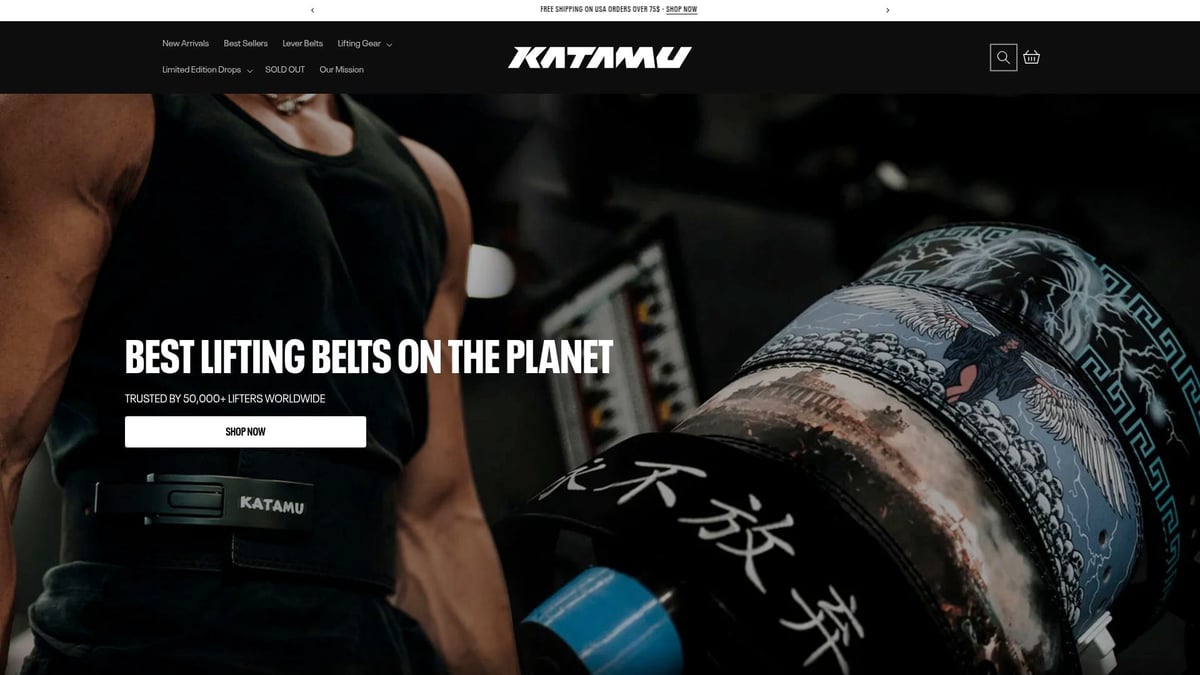
You’ll find bundled kits, a one-year warranty, and free shipping on US orders over $75, adding real value to your investment. Over 50,000 lifters worldwide trust Katamu for reliable, stylish support.
With free wrist wraps included with every belt, Katamu ensures you’re equipped for your next PR. Their community-driven ethos makes them a top choice for those seeking quality, comfort, and standout style in 2025.
Now that you know what to look for in a lifting belt—material, thickness, fit, and all the details that matter—choosing the right support for your goals in 2025 just got a whole lot easier. At Katamu, we’re all about helping you unlock more from every session with premium gear that’s built to last (and look good doing it). Whether you’re a seasoned lifter or just getting started, you deserve a belt that works as hard as you do. Ready to take the next step toward safer, stronger lifts? Build your setup and feel the Katamu difference for yourself.
